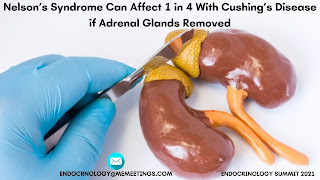Nelson’s Syndrome Can Affect 1 in 4 With Cushing’s Disease if Adrenal Glands Removed
Some 25% of Cushing's sickness
patients — or 1 in each 4 — will foster Nelson's condition (NS) after medical
procedure to eliminate both adrenal organs, while around 1 in each 5 will
require pituitary-explicit therapy, an investigation found.
Long lasting follow-up is
likewise required for patients who go through twofold adrenal organ expulsion,
otherwise called respective adrenalectomy, since the danger of creating NS can
continue for as long as forty years.
Reciprocal adrenalectomy used to
be the standard treatment for Cushing's sickness, an issue wherein amiable
tumors in the cerebrum's pituitary organ cause the adrenal organs sitting on
the kidneys to deliver extreme measures of cortisol.
In the course of the most recent
couple of many years, be that as it may, different therapies, like pituitary
medical procedure, radiation treatment, and prescriptions to adjust cortisol
levels or impacts, have generally supplanted it
Two-sided adrenalectomy, albeit
thought about protected and viable, has eminent downsides. Two significant ones
are constant adrenal deficiency and an expanded danger of NS, a condition where
the leftover pituitary tumor proceeds to develop and create unnecessary
measures of adrenocorticotropic chemical (ACTH). This can cause vision misfortune,
cerebral pains, and hormonal irregular characteristics — on the whole referred
to as chiasmal pressure — just as staining (hyperpigmentation) of the mucous layer
coating within the mouth.
The predominance of Nelson's
condition and its danger factors have involved discussion, differing starting
with one examination then onto the next.
To get a more complete
perspective on NS among individuals with Cushing's illness, analysts at a few
Swedish clinical establishments and colleges deliberately evaluated past
examinations, ordering and investigating their joined outcomes.
They distinguished 37
investigations, distributed somewhere in the range of 1976 and 2020, covering
1,316 Cushing's sickness patients treated with reciprocal adrenalectomy.
Post-medical procedure follow-up
occasions went from 3.3 to 22 years, with a middle development of seven years.
The middle period of time from a medical procedure to NS conclusion was four
years, in spite of the fact that it shifted between two months and 39 years.
The mean predominance of NS
across all examinations was 26%. This expanded to 31% when the group avoided
examines that came up short on a reasonable meaning of NS (different
definitions have been utilized) and rose to 38% among concentrates with MRI
filters — frequently used to find pituitary tumors — at determination and
during follow-up.
Specialists reasoned that
changing meanings of Nelson's disorder probably represented a significant part
of the inconstancy in its recurrence seen in various investigations.
"We believed the meaning of
NS to be clear when it included either another noticeable pituitary tumor or
movement of a pituitary tumor leftover after BA [bilateral adrenalectomy],
alone, or in mix with high ACTH fixations and additionally hyperpigmentation,"
the analysts composed. Generally speaking, 21% of patients in the
investigations (around 1 in each 5) required pituitary-explicit treatment for
NS. By and large, treatment comprised on radiotherapy, trailed by pituitary
medical procedure, lastly by a blend of both.
Neither earlier pituitary medical
procedure, radiotherapy, nor age at reciprocal adrenalectomy seemed to
influence the danger of creating NS. The agents noted, nonetheless, that the
modest number of studies remembered for their examination keep this from being
a solid end.
The key hormones produced by the adrenal gland include:
1) Cortisol.
2) Aldosterone.
3) DHEA
and Androgenic Steroids.
4) Epinephrine
(Adrenaline) and Norepinephrine (Noradrenaline)
5) Adrenal
Insufficiency
6) Congenital
Adrenal Hyperplasia.
7) Overactive
Adrenal Glands.
8) Excess
of Cortisol: Cushing Syndrome




Comments
Post a Comment